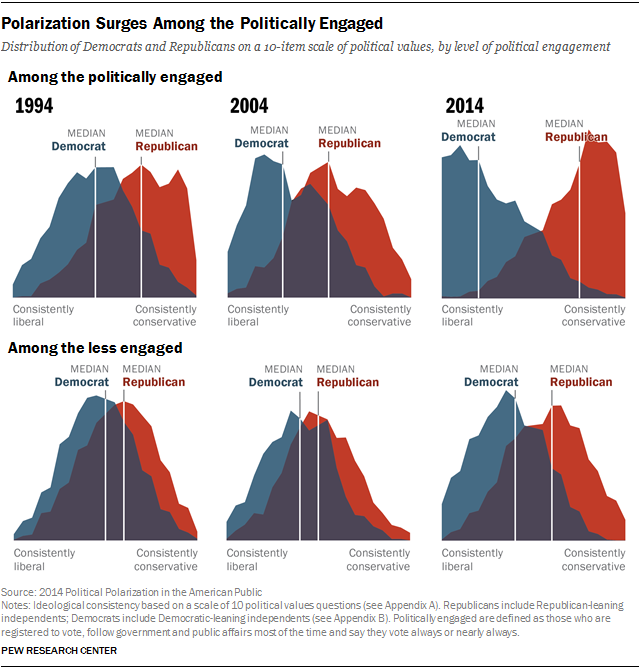The interactive chart below illustrates the shift in the American publics political values over the past two decades using a scale of 10 questions asked together on seven Pew Research Center surveys since 1994. But these surveys gauge animosity at the conscious level.
 Political Polarization And Growing Ideological Consistency Pew Research Center
Political Polarization And Growing Ideological Consistency Pew Research Center
It refers to the level of overlap between the two parties on various.
/cdn.vox-cdn.com/uploads/chorus_asset/file/4178032/polarization.0.png)
Political polarization over time. In fact this out-group animosity marks a deeper divide than other considerations even race see graph below. Both Guber 2013 McCright and Dunlap 2011 claim that such political polarizationor increasing divergence over timeis consistent with party sorting theory eg Fiorina and Abrams 2008. The same kind of idea be it right or left wing keeps getting re-emphasized again and again.
Political Polarization Over the Years Polarization happens. Layman et al 2006 whereby party activists and ideological leaders drive polarization among political elites and this process sends cues to voters that party positions are changing. The result of elite polarization has too frequently been gridlock as elites prioritize partisan wins over the needs of.
This graph is a comparison of the new model created. Over Two Decades of Differences. Something similar has happened over time with us due to social media.
The polarization of political parties over time. The data is based on surveys of over 5000 adults to gauge public sentiment tracking the dramatic shifts in political polarization in the US. Jun 9 2018 5 min read Political polarization has become a household term for explaining the current state of US politics.
We can all see it when we turn on the TV go online or do a variety of other things. Over time Democrats and Republicans have become more polarized in their views of the nations presidents PEW RESEARCH CENTER Those most active in politics are the most ideological. Unlike interest-group measures that consider only certain votes and are often geared toward.
KAnder10 Designs Here we can see. As an example consider attitudes toward government policies related to abortion. In a political world where polarization grows more extreme over time dealing with the political issues of the day becomes more and more difficult Lo said which is why this is an issue.
Politics is asymmetric as it has primarily been driven by a. Due to its overexposure it has becomes easy to absorb one kind of idea and difficult to accept the other. Political activists in each party tend to push for policies that are further to the left in the Democratic Party and further to the right in the Republican Party.
Is polarizing faster than other democracies study finds. The switch from an agricultural to industrialized economy at the beginning of the 20th Century and the time. Measuring Political Polarization Over the Past 100 Years The two measures of political polarization we consider are the Poole and Rosenthal 1997 2007 indexes of polarization in the House and Senate PolarH and PolarS respectively.
This section highlights four of the many factors that are likely contributing to polarizations rise. Political Polarization 1994-2017. The share of Americans with ideologically consistent values has increased over this time and these.
Polarization is a historically common feature of the politics of the United States. The results are a fascinating deep dive into Americas shifting political sentiment. Polarization in voting patterns and absence of cross-party co-operation has become increasingly stark among American politicians over several decades.
One of the main ways we can see polarization in the world today though is in politics. Political Polarization Over Time. In contrast to ideological polarization in the electorate polarization among American political elites is no illusion.
Americans feelings toward members of the other political party have worsened over time faster than those of residents of European and other prominent democracies concluded a study co-authored by Brown economist Jesse Shapiro. Common scholarly questions about political polarization include how the magnitude of modern polarization compares to its past magnitude and the extent to which polarization is a feature of American politics and society. Likewise social distance between parties has increased over time as measured by stereotypes of party supporters and marriage across party lines.
A simple definition of policy polarization is a process where extreme views on some matter of public policy have become more common over time. From 1994 to 2017. Political polarization the vast and growing gap between liberals and conservatives Republicans and Democrats is a defining feature of American politics today and one the Pew Research Center has documented for many years.
